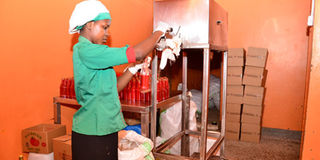TradeMark EA commits Shs27 billion to women in business

A woman packages tomato sauce at Macdough Foods Uganda Ltd. PHOTO BY DOMINIC BUKENYA
Kampala. After injecting at least $80 million (nearly Shs240 billion) in infrastructure developments, resulting in reduced cargo transit times at East Africa’s main transport corridors, focus will now be shifted on how Small and Medium Enterprises (SMEs) can use their facilities.
Considering that these traders, most of whom are women, do not use available formal systems for their transactions, it is difficult for regional trade policy initiatives to impact on their operations. To increase their access to markets, TMEA and other institutions will facilitate the formation of cooperatives for informal women traders.
While launching its annual report in Kampala last week, TradeMark East Africa (TMEA) chief executive officer Frank Matsaert, said $9 million (nearly Shs27 billion) will be committed in facilitating businesses in Uganda with a focus on improving SMEs competitiveness and formalising informal trade.
SMEs competitiveness will be improved through harmonising product standards, cutting bureaucracies and fast-tracking clearance procedures.
In terms of informal trade, the lifeline of most rural livelihoods, business women’s work should be improved since they are major players in this industry.
The permanent secretary in the Ministry of East African Community Affairs, Ms Edith Mwanje, said: “I am glad that there is focus on women informal traders who are responsible for up to 60 per cent of all intra-East African trade.”
Meanwhile, according to TMEA’s annual report for 2013/2014, its partnership with East African governments has resulted in great progress in delivering One-Stop Border Posts (OSBP) in the region to increase physical access to markets for both formal and informal traders.
A statement issued on behalf of TMEA quoted Trade minister, Ms Amelia Kyambadde, as commending TMEA initiatives which have supported the ministry in elimination of non-tariff barriers, enhancing the quality of infrastructure and the implementation of the National Electronic Single Window.
This is in addition to upgrading the URA customs management system which has so far led to a reduction in border clearance time from four days to a day, reduction in transit days within Uganda from eight days to two days and a cost saving of $2.5m (about Shs7b) per year to the private sector.”
Challenges
increased threat of violence and terrorism has negatively impacted on projects. However, they hope to see a 10 per cent increase in the total value of exports from the EAC region and a 25 per cent rise in intra-regional trade exports when compared to total exports in the region by 2016.




